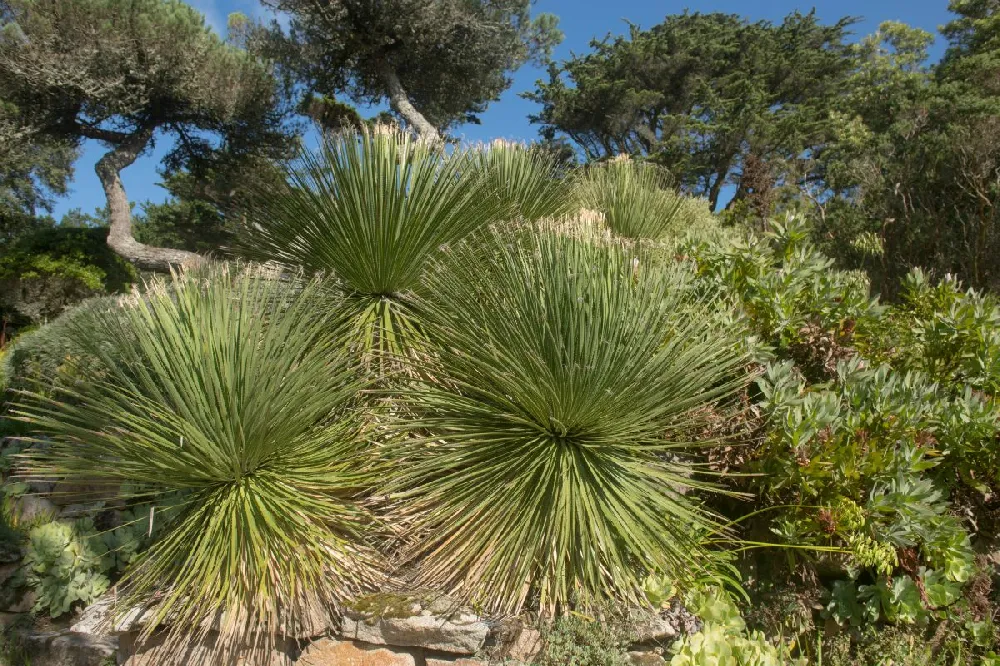- Home >
- Houseplants >
- Snake Plant Laurentii
Snake Plant Laurentii for Sale - Buying & Growing Guide
- Ships in 1-2 days
- 1-Year Warranty Eligible
- Pots or accessories are not included unless specified in the product options.
Shipping Details:
Once your order is shipped, you’ll receive an email with a tracking number and estimated delivery date. Most orders ship immediately, but some items are seasonal and may only ship in spring or fall. These products are noted on the website.
The tall green spears of the Snake Plant (Laurentii) offer constant color and beauty with the added advantage of being among the easiest plants in the world to care for. Often referred to as the die-hard of all plants, snake plants will thrive indoors and out, need very little water, and are indifferent to the amount of light that they receive. They are the perfect plant for a beginner, a traveler, or anybody who wants the perks of a living plant without the responsibilities.
- The thick, tall leaves of the Snake Plant laurentii have variegated green bands and often feature bright yellow edging along each of their sides.
- Overwatering poses the biggest risk to the health of a Snake Plant. The amount of water your Snake Plant needs will depend upon its light exposure, with a general range of every two to six weeks.
- Snake Plant leaves can grow from 6” tall to 8’ tall.
- Snake Plants are known for their ability to purify the air, and they are particularly adept at removing formaldehyde and benzene from the environment.
Plant Care
Sunlight

Can grow well in many light conditions but prefers to receive about 4 to 6 hours of indirect sunlight.
Watering
Tolerates dry soil well. Water occasionally when the soil has become dry.
Fertilizing

Fertilization needs are low. Apply a balanced fertilizer once per growing season.
Planting and Care
Planting instructions
Snake Plants can survive in a wide range of light conditions, but it’s still possible for them to experience leaf scorch if they’re grown in direct sunlight. The plant’s popularity is based as much on the beauty of its deeply shaded green leaves and height as on its hardiness. You can place it in conditions ranging from very bright light to rooms with almost no sun exposure and they will adapt, though they grow best in rooms with indirect, steady light. They prefer temperatures between 70 to 90 degrees and will not tolerate temperatures below 50 or a spot near a drafty window. If you’re growing a Snake Plant outside in a garden, plant it in a container to keep it from spreading — the plant multiplies through underground runners and can easily get out of control.
Snake Plants are drought-resistant and seem to prefer to remain on the dry side. Plant them in soil that is loose and drains well. A commercially prepared cactus mix is a good choice, as are other soils on the sandy side. Their roots are extremely strong, so plant them in containers with strong walls or you are likely to see them crack as your plant grows. Terra cotta pots are a good choice, as they absorb excess water.
A Snake Plant kept in the sunshine will grow quickly, so anticipate repotting or dividing it once or twice a year, preferably in the spring. If your plant is potbound it may flower. Whenever you repot, provide your plant with fresh potting soil, and don’t bury them too deeply. Always choose a container that has drainage holes in the bottom. It’s a good idea to wipe the leaves down every once in a while, as they do collect dust.
Watering and nutrients
A Snake Plant will not tolerate being overwatered. If the soil is too moist it will quickly develop root rot. When in doubt, err on the side of underwatering, and do not rely on the soil’s surface as an indicator of dryness. You need to stick your finger a couple of inches into the soil to make sure that you don’t feel any moisture at all before watering. A good way to both avoid root rot and encourage strong root growth is to water this plant from the bottom rather than from the top. By placing water into a dish that the plant sits in, you encourage the roots to grow farther down in the soil, giving your Snake Plant greater stability.
A Snake Plant that is kept in bright light will require watering more frequently than one in a darker room, but as a rule of thumb a Snake Plant should not be watered any more frequently than every two weeks, with some not needing water for as long as six weeks. During the winter the plant will require even less water.
Snake Plants respond well to fertilizers designed for cactus. This should only be provided during the growing season. If you choose a slow-release fertilizer, dilute it to half strength.
Propagation
Snake Plants are extremely easy to propagate, and if planted in a garden they will spread invasively via their underground rhizomes. The rapid growth of a plant kept in a container in a sunny spot may make division a necessity, and this is the easiest way to propagate. Just unpot the plant and divide up the leaves into as many groups as you want. The roots will separate along with the leaves and be ready for repotting.
Snake Plants can also be propagated via cuttings. Just snip off the top few inches of a leaf and put it into the soil or place the cut end into a cup of water. It will develop roots, though this method takes longer and is more likely to lose the plant’s distinctive markings.
Pruning
Snake Plants do not require pruning beyond what is needed to remove any leaves that have died or to make the plant look better. It is a good idea to remove damaged leaves to ensure that the plant devotes its energy to healthy new growth rather than to healing injuries.
Pests, diseases, and animals
The low-maintenance nature of the Snake Plant extends to its resistance to pests and disease. Leaves that become soft or turn brown may be impacted by root rot or another disease, but they can be addressed by removing any affected leaves with a sharp scissor and allowing the plant to dry out. Snake Plants rarely attract pests of any kind, but if you do spot mealybugs or spider mites they can easily be taken care of by wiping the leaves down with neem oil, or even with a mixture of liquid soap and water.
Light
The Snake Plant can adapt very well. It can withstand full sun conditions, but it prefers and thrives in indirect sunlight and grow light. This makes it ideal for growing indoors.
Indoor artificial lights like Fluorescent bulbs which exist in any offices and houses can give this plant enough light to live healthily. However, to make it grow faster and more vigorously, you’ll need more light intensity and duration.
Flowering
The Snake plant flowers have a green to white color. Moths pollinate them outdoors. These plants are known to produce very few seeds after fruiting. Once a shoot blooms, it does not produce flowers anymore, and instead, it produces little plants which grow at the rhizomes.
Common Problems of the Snake Plant
Bloated, stinky leaves
This is a result of too much watering or waterlogging the garden. Excess water leads to the explosion of the plant cells within the leaves, and this causes bloating and odor.
You should remove the affected leaves and correct the water problem before it affects the whole plant.
Brown leaves
Brown leaves might also appear crunchy. This is a sign of not watering the plant. Remove the brown leaves and correct the problem by watering the plant whenever the soil around it is dry.
Brown leaf tips
Brown tips on a Snake plant can indicate inconsistent watering or too much watering. Don’t remove the tips, though, as this leads to scarring of the plant. Instead, adjust the watering schedule and let the plant recover on its own.
Scarring
This is caused by too much touching of the leaves or brushing against them. The Snake plant has very smooth leaves and if left in open areas where people are passing by or children are playing, scarring will be inevitable. Likewise, any rough handling of the Snake plant will cause it to scar.
Benefits of the Snake Plant
CAM metabolism
Crassulacean Acid Metabolism is one of the major reasons why people fancy using the Snake plant in their bedrooms and bathrooms. Plants utilize carbon dioxide during the day and oxygen at night. Placing too many plants near your sleeping area is always discouraged because the plants could use up available oxygen and lead to suffocation.
However, the case is different where the Snake plant is involved. This plant releases oxygen into the air at night by converting carbon dioxide to oxygen, which in turn, people breathe as they sleep, and this leads to an increased supply of fresh air.
This property of the Snake plant has been used to cure Sick Building Syndrome due to its constant supply of oxygen.
Aids in eliminating bad odor
A foul scent in the house can be uncomfortable. For example, when you paint a room, the smell can be unbearable, especially to kids in the house.
The presence of the Snake plants in such a room cleans up the air so that you can paint or use other strong chemicals more safely.
Types of Snake Plants
Sansevieria trifasciata is recognized majorly as a plant with green-yellow leaves. However, it has a variety of cultivars to choose from, depending on preference. They are distinguished based on the leaf color.
Sansevieria trifasciata ‘Black Gold’

Its leaves have dark green centers that are surrounded by light yellow to gold edges.
Sansevieria trifasciata ‘Futura Robusta’

This is the shortest variety. The leaves are silvery green with dark green stripe.
Sansevieria trifasciata ‘Futura Superba’

Futura Superba snake plant looks just like the smaller version of the Black Gold type with similar leaf pattern & colors but it has wider leaves and is shorter in height.
Sansevieria trifasciata ‘Cylindrica’

This is the most unique variety of the Snake plant because the stems have a round shape similar to bamboo stalks.
Sansevieria trifasciata ‘Golden Hahnii’

This is the brightest cultivar with thick gold edges and a light green center.
Sansevieria trifasciata ‘Black Jack’
It is similar to the Black Gold variety, but it is shorter.
Sansevieria trifasciata ‘Black Robusta’
The leaves are dark green with silver sprinkles.
FAQs
Are Snake Plants safe around pets and children?
Are there different varieties of Snake Plants?
There are over 60 different types of snake plants to choose from, and all of them are easy to care for. Some are as short as just six inches and form compact clusters, while others can grow as high as 12 feet. There are snake plants whose leaves twist, and others whose leaves are thin and tinged with red.
How can I tell if I’m giving my Snake Plant too much water?
Root rot is often hard to spot until it’s too late, as the first signs appear underground, on the roots themselves. The symptoms will eventually reach the leaves, which will turn yellow, wilt, or droop, eventually becoming mushy. A root rot problem is best addressed by repotting the plant, removing and refreshing the soil, and pulling away anything that looks unhealthy. If the entire root or base is impacted, take a cutting from healthy leaves and start over.










